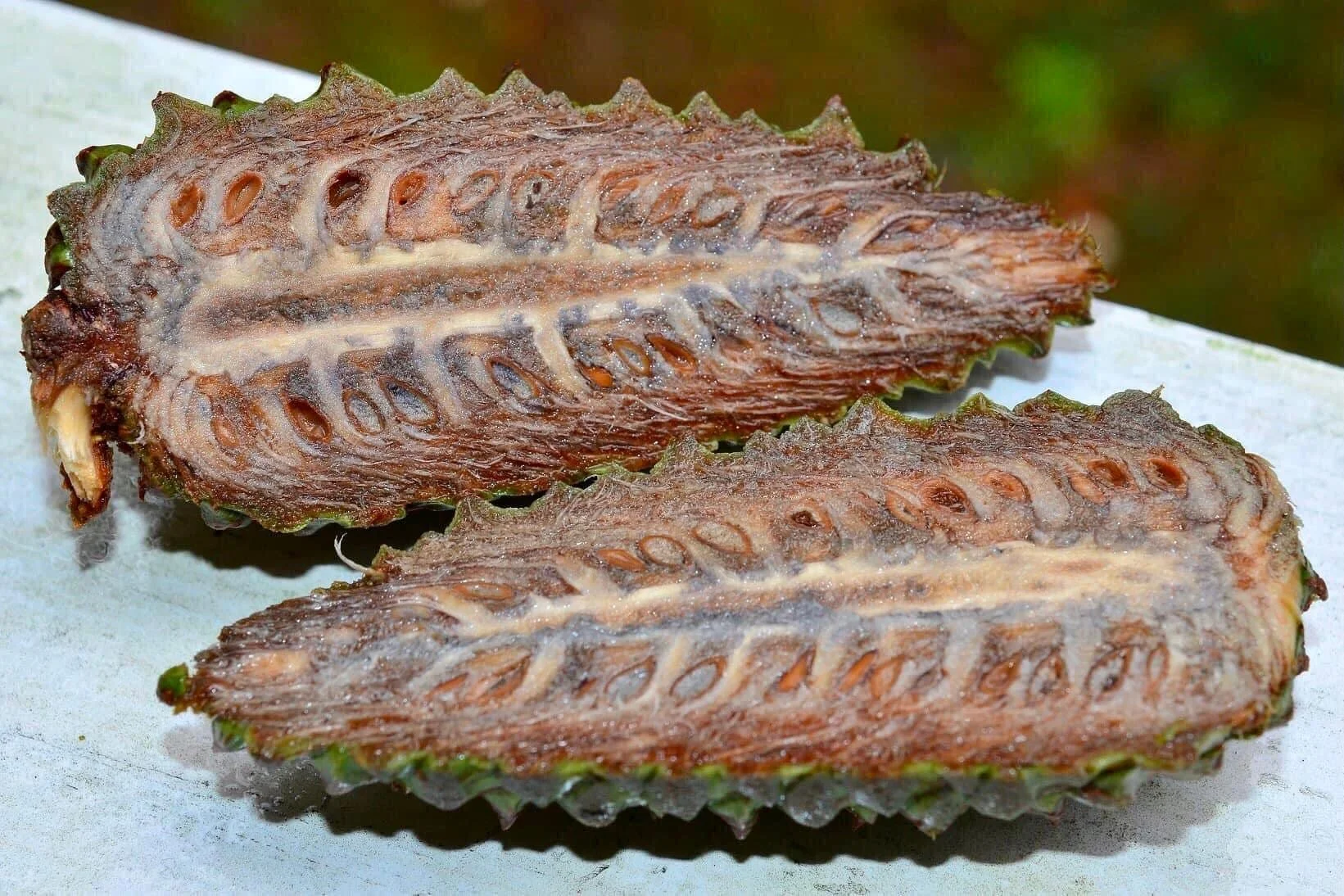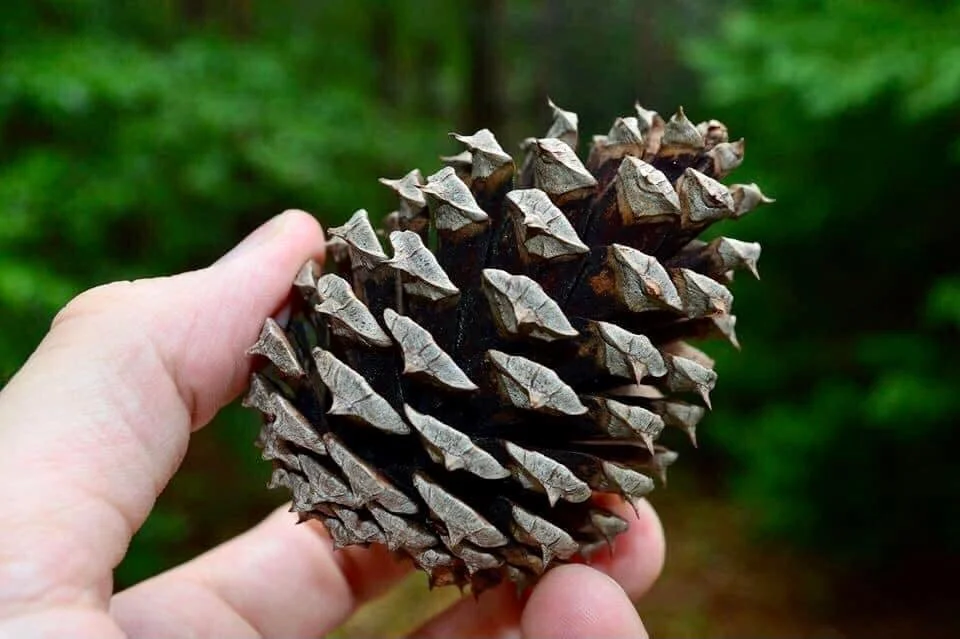Today’s guest blog is a special Christmas treat. The information was written by Dr. Jon Storm, who pens the popular Facebook Page, Southern Piedmont Natural History, and is reprinted with his permission. If you have ever wanted to identify a pine tree, read on. Don’t miss the tidbits accompanying each of the fabulous photos.
Across the Piedmont of the Carolinas and Georgia, the most common pine trees you will find are the loblolly, shortleaf, and Virginia pine. They can be distinguished by the length, shape, and bundling of their needles. Two other pines you might occasionally find are the longleaf and eastern white pine. All of them are native.
Eastern White Pine (Pinus strobus) has thin, flexible needles that are 3-5 inches long. There are 5 needles per bundle (fascicle). One way to remember this is that ‘white’ has 5 letters. The needles also have a bluish-green color relative to our other pines. Eastern White Pines are more common in the Blue Ridge, but you can occasionally find them in woodlands of the upper Piedmont.
Loblolly Pine (Pinus taeda) has dark green needles that come in bundles of 3. They are stiff and 6-9 inches long. This pine is abundant in the Piedmont and is often planted in pine plantations.
The name Longleaf Pine (Pinus palustris) speaks for itself. It’s much more common in the Coastal Plain, but you can occasionally find some, perhaps planted, in the Piedmont. Its needles also come in groups of 3, but they are 10-18 inches long! Historically, this was the dominant pine tree of the Coastal Plain. Longleaf Pine requires wildfires to germinate and not be outcompeted by other trees.
Shortleaf Pine (Pinus echinata) has needles in groups of 2 and occasionally 3. Needles are 2.5 - 5 inches long and straight. This tree grows across the Piedmont in dry, rocky woodlands and open fields.
Virginia Pine (Pinus virginiana) has 2 needles per bundle, with each needle being 1.5 - 3 inches long. Its distinguishing feature is that the needles twist. Virginia Pine has a scrubby appearance from the retention of its dead lower branches.
Pine cones are often used in wreaths and other Christmas decorations. But what are cones and what purpose do they serve to the tree? The cones you see in wreaths are the mature, seed-bearing female cones. In many pine trees, such as the Loblolly Pine (Pinus taeda) shown below, female cones develop over 2.5 years.
These are 1st year female (ovulate) cones developing near the end of a Loblolly Pine branch. They have soft scales and begin forming in winter and then start a rapid development once warmer spring temperatures and longer days arrive. These cones receive pollen from the male (staminate) cones in early spring. Female cones develop on the upper branches, while the male cones are on the lower branches. This helps ensure cross-pollination between trees and enhances the genetic diversity of offspring relative to self-pollination.
This is a 1st year female cone that I sectioned lengthwise with a scalpel. This cone was sectioned shortly after pollination in spring (you know, that time of April when everything seems covered in the yellow dust of pine pollen). Sticky pollination drops on the outside of female cones help pollen adhere. Notice the tiny pollen grains inside the female cone. Only the scales near the middle of the cone (the fertile scales) are capable of producing seeds. Believe it or not, the eggs in the female cone won’t be fertilized until late spring to early summer of the following year! During this first year, the female cones stay relatively small.
I cut lengthwise down this unopened 2nd year female cone with a coping saw to show the developing seeds. This is a late-summer female cone that would have opened up in late autumn and likely then released its seeds in early winter.
You may have seen pine nuts in the grocery store. These are generally the seeds from one of the Pinyon pine species native to the southwestern US or another species in Europe or Asia. Cutting this loblolly cone open gave me some appreciation for the hard work squirrels do to harvest the seeds!
Mature female Loblolly Pine cone. Each scale (bract) has 2 seeds develop of its top surface. If you look on top of a scale, you can sometimes see some seeds or a light discoloration where the 2 seeds used to reside. Loblolly Pine female cones have a sharp spine on the end of each scale. Most trees drop these cones shortly after the seeds fall out.
This branch has two new, green female cones near the end of the new shoot. These soft cones will receive pollen in spring.
Below them, there are 2 female cones that were pollinated the previous spring. These cones are typically around 1 inch long and will have their eggs fertilized in late spring to early summer. These cones will start to grow rapidly during the spring and summer.
Below them, are 3 nearly mature female cones. These would typically have opened up and dropped their seeds in the winter. Many factors, such as temperature, precipitation, insect damage, and the genetics of the variety (much of the loblolly pine you see was planted) can influence cone and seed production.
Seeds removed from a mature female cone. Here in the Piedmont, cones typically mature in late fall and then seeds are dropped around early winter. Seed production is often highly variable between years and the particular clone planted in an area (much of the loblolly pine you see in woodlands and yards was planted).
Dr. Storm and his students put together a must-have book for naturalists in the NC/SC area, Field Guide to the Southern Piedmont. It is a free download. (Click HERE).
Merry Christmas, friends. I hope Santa brings you a nice, sharp pair of pruners!






